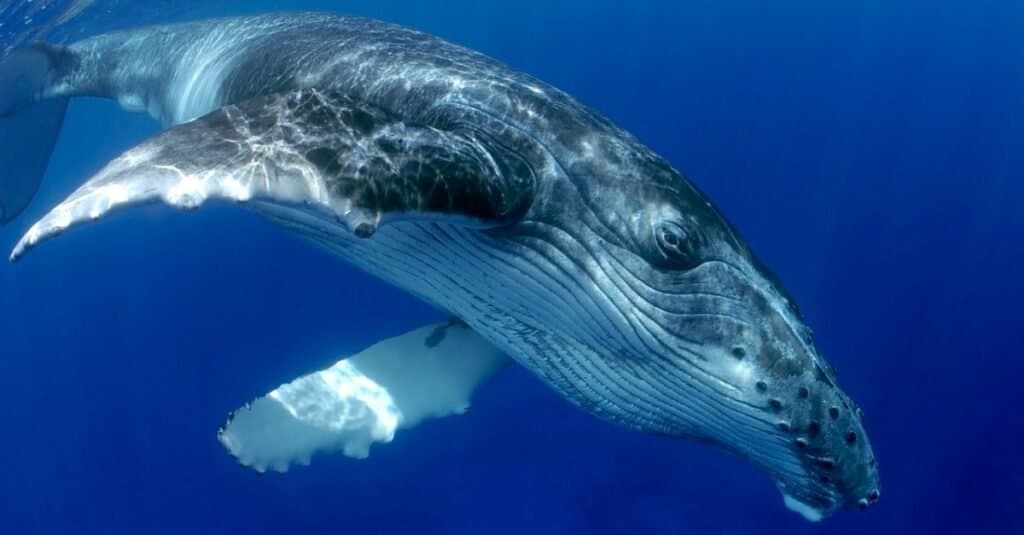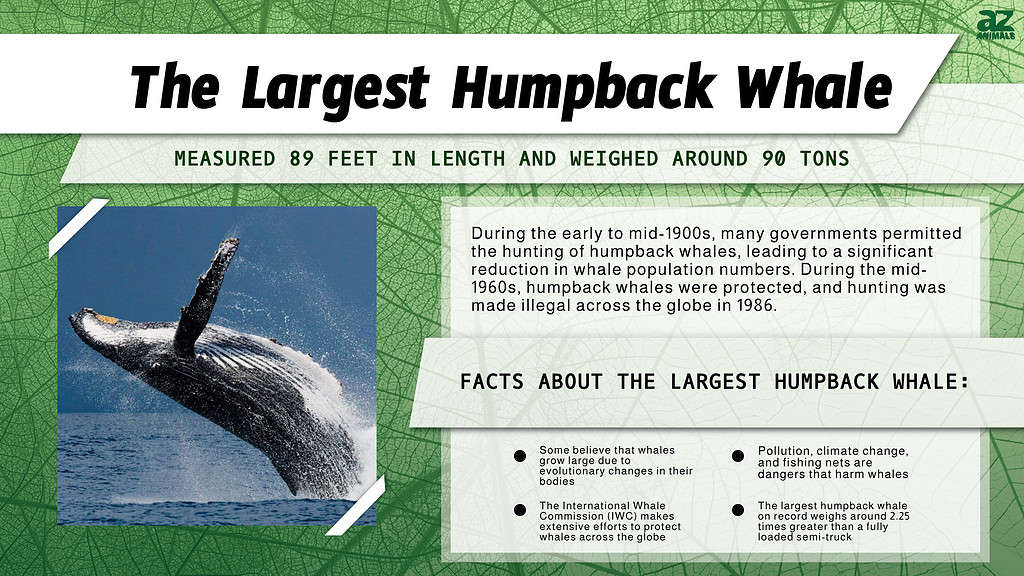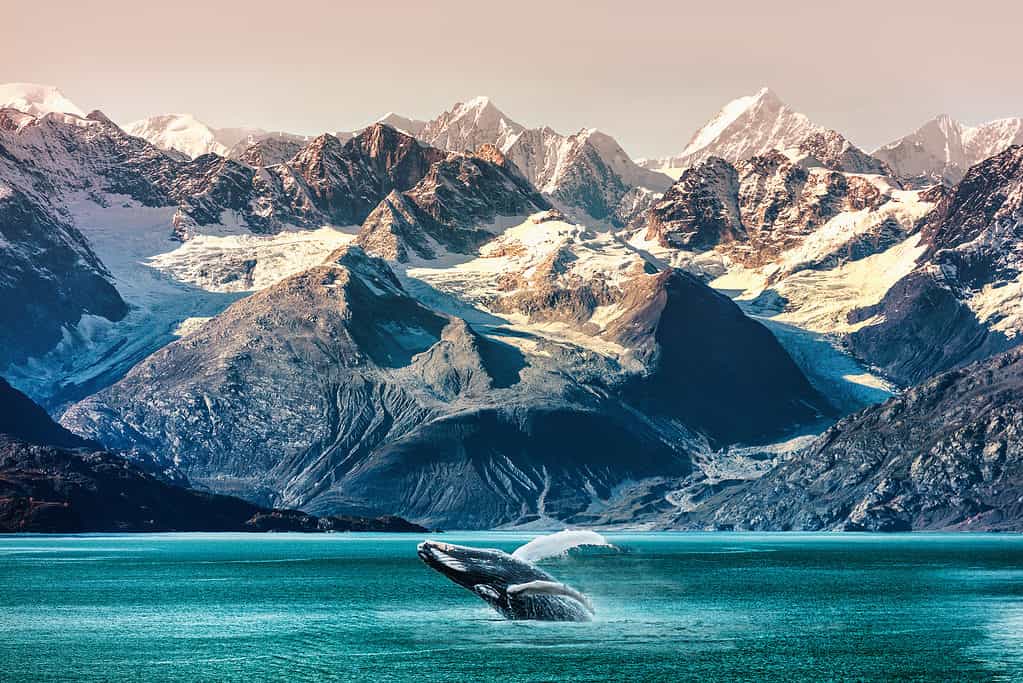Introduction
Humpback whales are massive creatures that swim in almost every part of the world. While other whale species are significantly larger than the humpback, the humpback whale remains a huge marine animal. In fact, the largest humpback whale ever recorded weighed as much as five average-sized semi-trucks. Find out more about the largest humpback whale on record and discover other record-breaking whales.

Humpback whales are some of the largest creatures on Earth!
©iStock.com/Yann-HUBERT
Background on Humpback Whales
Humpback whales typically measure between 39 and 52 feet in length, and they weigh around 40 tons, on average. The coloration of the humpback whale is black on the upper part of the body with some white on the underbelly. One feature of the humpback whale that differentiates them from other whale species is its flippers, which are narrow and around one-third as long as their entire body length.
The diet of the humpback whale includes crustaceans, such as small fish, plankton, and krill. Whales consume prey in a unique way, which is called bubble netting. During bubble netting, the humpback whale swims below prey and exhales bubbles, which encompass the prey, trapping them. Then, the whale swims upward through the bubbles and captures the prey.
Furthermore, the humpback whale is known for its incredible songs. These songs derive from certain sounds made by humpback whales, such as groans and moans. The combination of humpback whale sounds creates songs, and these songs can be extremely long. In fact, some songs may last a maximum of 35 minutes. In addition, the songs produced by whales change according to the group of whales, the region in which they reside, or by season.

Where do Humpback Whales Live?
Humpback whales are typically found in coastal waters in almost every corner of the world. All oceans act as homes for these creatures, and humpback whales may swim into rivers or harbors. During summer, humpback whales travel to cooler waters in search of prey. On the other hand, winter sends the humpback whale to tropical waters, where whales mate.

Humpback whale migration depends on the season. The feeding grounds of the species are usually in polar waters, during summer, while breeding grounds reside in subtropical or tropical waters in winter.
©EreborMountain/Shutterstock.com
The Largest Humpback Whale Ever Recorded
The largest humpback whale on record measured 89 feet in length and weighed around 90 tons, which translates to around 180,000 pounds. A semi-truck that carries a full load achieves a maximum of 80,000 pounds, but the smallest semis weigh around 25,000 pounds. Therefore, the largest humpback whale on record weighs around 2.25 times greater than a fully loaded semi-truck and over seven times greater than the smallest semi-truck. The largest humpback whale on record weighs around five times more than an average-sized semi-truck that carries an average amount of goods to transport.
How did Humpback Whales Grow So Large?
Some believe that whales grow large due to evolutionary changes in their bodies. During the recent Ice Age, which occurred around 100,000 years ago and lasted until 25,000 years ago, it’s possible that whales adapted to preserve the species. Ice ages typically lead to less food and prey availability. Thus, whales would have had to adjust to store fat in their bodies. Fat storage would allow the whales to wait longer before finding a food source and give them more energy in searching for prey.
On the other hand, some experts think that humpback whales grew larger over time due to competition with other species and between themselves. In addition, scientists point to predation being the reason behind humpback whale size. It’s possible that larger ancient predators resulted in extreme humpback whale growth so that the whales could better protect themselves and escape predation.
Overall, though, many researchers agree that the Ice Age theory is most likely the reason behind the humpback whale’s incredible growth. During this period, the climate changed frequently, which resulted in increased nutrients within coastal waters. Thus, whales that traveled to these waters were able to find abundant prey and grow larger. However, other areas were practically devoid of all life. Therefore, whales that gathered coastal nutrients better stored fat, allowing them to grow to immense sizes and to travel to areas with more nutrients after depleting one region.

During the Ice Age, whales may have stored fat from increased nutrients in coastal waters, which is one theory that points to their incredible size.
©Maridav/Shutterstock.com
Other Massive Whales
In addition to the largest humpback whale, other whales have broken records in size. For instance, the longest blue whale ever recorded measured around 110 feet in length. The heaviest blue whale on record weighed 190 tons, which translates to 418,878 pounds. The heaviest blue whale weighs over two times greater than the heaviest humpback whale. The average blue whale weighs 160 tons, as it is the largest species of whale. In addition, many experts believe that the blue whale is the largest animal to have ever existed. Another large whale, the fin whale, records an average weight measuring 110 tons, and the fin whale may grow to lengths of 85 feet.
Threats to Humpback Whales
During the early to mid-1900s, many governments permitted the hunting of humpback whales, leading to a significant reduction in whale population numbers. During the mid-1960s, humpback whales were protected, and hunting was made illegal across the globe in 1986. Humpback whale populations began to recover, and the International Union for Conservation of Nature (IUCN) moved humpback whale classification to vulnerable, where they had previously been endangered.
While humpback whale populations have increased, dangers still exist that threaten humpbacks and other whale species. For instance, pollution, climate change, and fishing nets are dangers that harm whales. Pollution in oceans, such as marine plastics, can be swallowed or choked on by marine animals. In addition, pollution lowers the water quality, which is harmful to animals. Climate change causes decreased population numbers of many species and destroys the natural habitats of marine life, such as coral reefs. Finally, marine animals may become caught in fishing nets unintentionally, which results in injury and possible fatality.

Pollution can be a major threat to marine life, as it decreases water quality in oceans and contributes to climate change.
©iStock.com/Максим Шмаков
Conservation of Humpback Whales
The International Whale Commission (IWC) makes extensive efforts to protect whales across the globe and to regulate the harms that are dangerous to whale populations. For instance, the IWC regulates whale watching. While whale watching can certainly bring benefits to whale populations, such as increased awareness and funds allocated to conservation, whale watching must be managed to ensure that the activity is being done responsibly. The Whale Watching Handbook produced by the IWC helps whale watchers understand how to achieve responsible whale watching. Discover other ways in which the IWC protects whale populations.
Marine Plastics
In addition, the IWC regulates the number of plastics deposited into oceans. Working with the United Nations Environment Program, the IWC decreases plastics in the ocean, manages marine plastics in protected areas, decreases the number of plastics the IWC uses in their operations, and determines which marine areas contain the most plastics.
Fishing Net and Vessel Collision
The entanglement of whales in fishing nets is another area of harm that the IWC regulates. Through research, IWC can determine which avenues to take in decreasing the instances of marine mammal entanglement in fishing nets. Furthermore, the commission uses a database to track the number of vessel collisions with whales. IWC distributes the data among several nations and conservation organizations, which work together to regulate this harm. For example, speed restrictions and altered shipping routes can decrease the number of whale and vessel collisions throughout Earth’s oceans.

Fishing nets may entangle whales, resulting in injury or death. Thus, commercial fishing must be regulated to ensure whale safety.
©OlegRi/Shutterstock.com
Commercial Whaling
While many countries prohibit commercial whaling, some nations still allow the killing of whales. Such nations include Iceland, Japan, and Norway. However, some nations are likely to make commercial whaling illegal soon. The country of Iceland does not profit from commercial whaling, and commercial whaling decreases tourism, as whale watching is a major part of Iceland’s tourism industry. Thus, Iceland is likely to be one of the first countries to outlaw commercial whaling. While Japan left the IWC due to commercial whaling regulations, the IWC hopes to change the minds of Japanese officials about commercial whaling, as operations in Japan hinder the work of the IWC to protect suffering whale populations.
Other Means of Protection
Other areas that IWC seeks to regulate are ocean acidification, disease, algal blooms, and chemical pollution in oceans. Ongoing research, experiments, and funding can aid IWC, alongside other conservationist organizations, in protecting whales and other marine mammals, like dolphins. The most endangered whale species that IWC seeks to protect include the North Atlantic right whale, California blue whale, Rice’s whale, Alaska bowhead whale, and more.
The photo featured at the top of this post is © Paul S. Wolf/Shutterstock.com
Thank you for reading! Have some feedback for us? Contact the AZ Animals editorial team.






